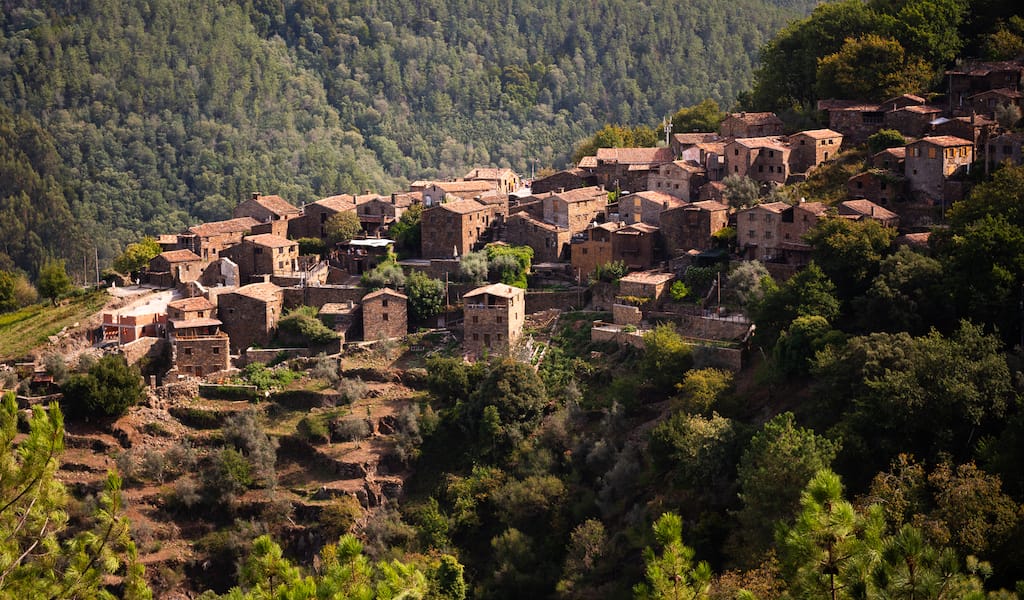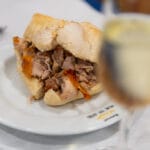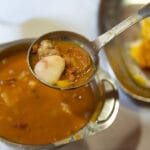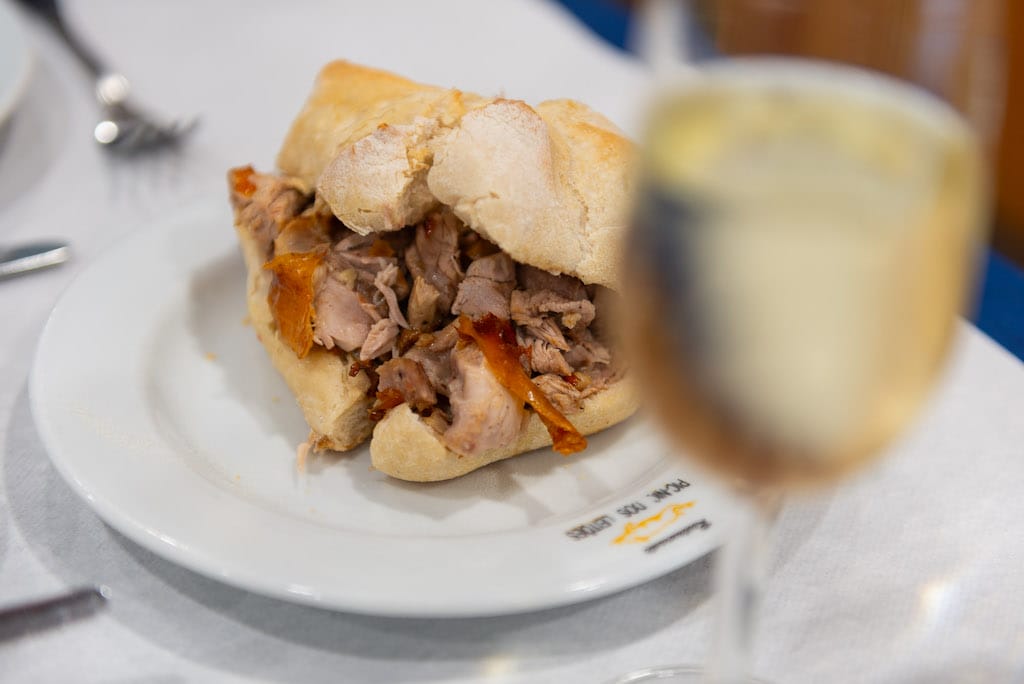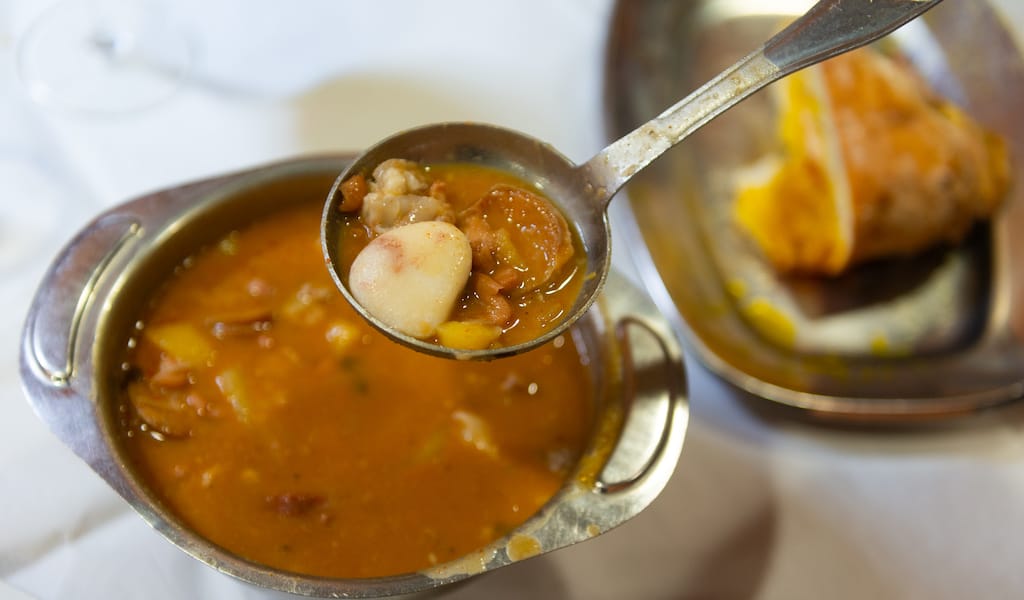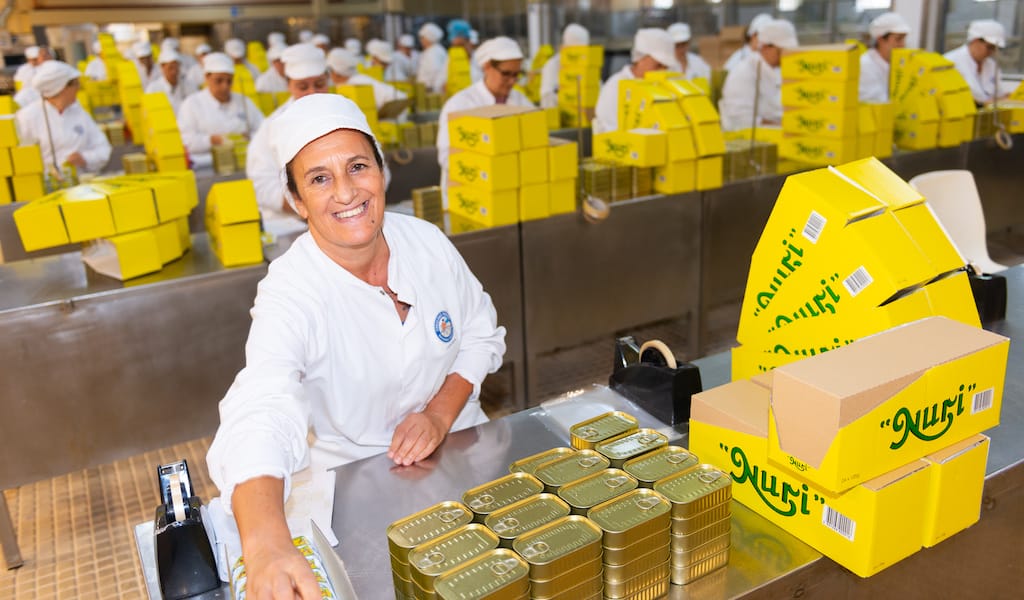“It’s not enough,” says the waiter at O Pascoal. We had inquired if one dish would be sufficient for three people, and his reply is immediate, firm and confident. We take his advice, order another, and the two dishes are easily enough for six people (we are three).
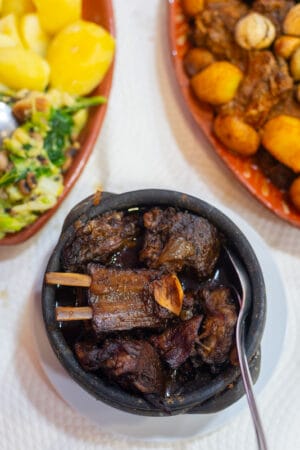 We are in Fajão, an aldeia do xisto, “schist village,” in inland, central Portugal’s Beira region – about a two-and-a-half hours’ drive from Porto, or around three hours from Lisbon – and this interaction is the perfect introduction to the almost comically hearty cuisine of this area.
We are in Fajão, an aldeia do xisto, “schist village,” in inland, central Portugal’s Beira region – about a two-and-a-half hours’ drive from Porto, or around three hours from Lisbon – and this interaction is the perfect introduction to the almost comically hearty cuisine of this area.
Schist, from the Greek schízein, meaning “to split,” is a type of metamorphic rock that, as the name implies, can be easily broken down. The stratified, mineral-flecked stone is so abundant in this mountainous, rugged area that locals used to use it to build their homes. By the end of the 20th century, people in Portugal were shifting to cities, and these tiny, remote, rocky villages were dying; in 1981, the schist village of Talasnal, for example, had only two full-time inhabitants. Yet located in areas of natural beauty and boasting a unique architectural style, some saw potential in the towns. In 2001, with support from the Portuguese government, the Aldeias do Xisto Network was created with the intent of “Mobilization of communities and the enhancement of their material and cultural heritage in order to generate new residential and tourism interest.”
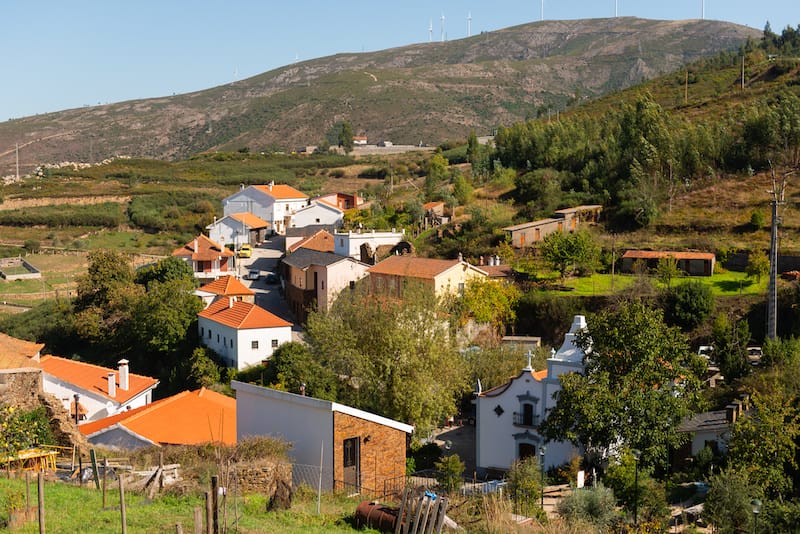
Today, the network links 27 schist villages spread out amongst four distinct geographic zones in an area roughly east of Coimbra. In some cases, the villages have seen a significant renaissance, the stone houses having been transformed into vacation homes, restaurants and art residencies. Others remain largely abandoned, perhaps with one or two renovated structures. Some villages feel like relatively modern towns where little schist is apparent, the stone having been plastered over, while others still feel frozen in a previous century. Authorities want visitors to approach the villages as jumping-off points for a variety of outdoor and cultural activities, one of which is the region’s unique cuisine.
“Nowadays, we call this dish chanfana,” explains Carlos Simão. He’s a native of Fajão and the owner of O Pascoal. We ask him to tell us more about the region’s most emblematic dish, goat oven-braised in wine in a clay pot, part of that gut-busting meal. “But in the old days it was called carne fresca (fresh meat),” he says. “People would kill a goat and it would go directly into the dish.”

Carlos explains that this stands in contrast to other meat dishes, which in this remote, mountainous region were almost exclusively made from preserved – salted or smoked – meats. He tells us that chanfana must be made with an old goat (“But not too old!”), which is made tender via that wine and three or four hours in the oven. At O Pascoal, the result is rich and fragrant – an immense, dark, clay vessel of fall-apart tender, bone-in goat, reduced wine and subtle herbs hiding under a generous layer of fat that slowly emerges during the long cook. The dish is paired with boiled potatoes and broa, the area’s emblematic cornbread, crumbled and mixed with black-eyed-peas and greens.
It’s delicious but hearty stuff, and we desperately need a digestif. Carlos plops two bottles on our table. One is aguardente de mel, booze distilled from honey and honeycomb, a local product that leaves the pleasant aroma of honey in our mouths for another half hour.
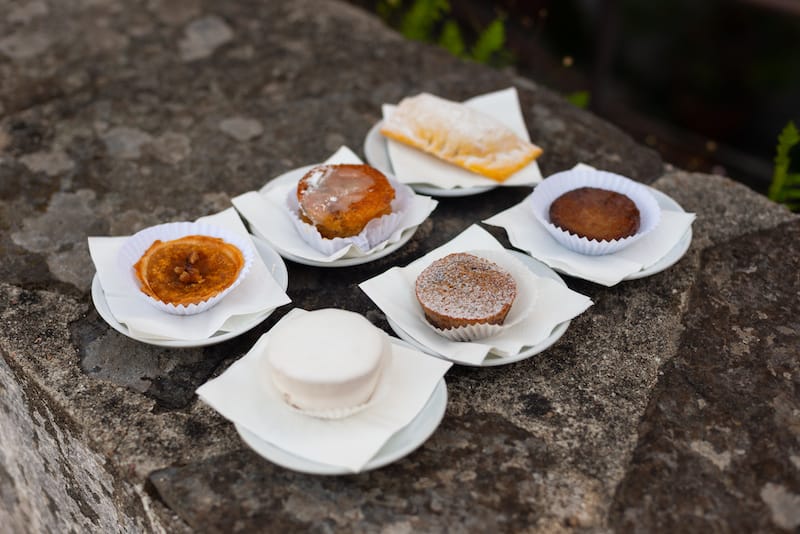
The greatest density of villages in the Aldeias do Xisto network is found in the Serra da Lousã range, not far from the city of Lousã. We make our base here, in the village of Candal, a small but buzzy tourist center that is home to Sabores da Aldeia, a restaurant that serves local dishes, as well as a small shop/cafe that is part of the official Aldeias do Xisto network of stores and restaurants. Like its counterparts, the shop sells a small selection of foodstuffs – jams, herbs, tisanes, wine and booze – from the region, but what catches our eye is a glass case displaying six different types of local sweets. We quickly become fans of pastéis de Alvites, small tarts filled with a dense, rich mixture of pumpkin and walnuts, a sweet created in Serpins, not far away.
Just up the road is the village of Cerdeira, where nearly all the schist houses that tumble down the 700 meter-high mountaintop are part of the Cerdeira – Home for Creativity, an arts-based community that offers residencies, a school and gallery, in addition to accommodation. There’s also a garden, and the Planta do Xisto initiative, also based in the village, is the source of many of the edible products sold at the Aldeias do Xisto shops.

In the opposite direction via a windy mountain road, Talasnal is arguably the schist village with the most to offer in terms of food and drink. In addition to an Aldeias do Xisto-recognized shop/cafe, which sells the usual selection of local items – including talasnicos, the village’s signature sweet, a mix of chestnuts, almonds, honey and lemon zest – there’s the bar O Curral. A whimsically tiny door here opens to a museum-like space filled with old bottles and antique knickknacks. There’s a small menu of light meals, including platters that revolve around local preserved meats and cheeses, but a highlight is the more than 16 different types of local liqueurs. We try one made from acorns – a ubiquitous ingredient in the region – which has a sweet flavor and a hazelnut-like aroma.
Talasnal is also home to Ti Lena, a restaurant named after one of the village’s last two inhabitants, and with a menu that spans just three dishes – salt cod, roasted goat and chanfana. Lisete Dias, the chef-owner, escorts us to the restaurant’s only outdoor table, a tiny balcony overlooking the village’s tiled rooftops and the valley beyond (“The best seat in the house”). She brings us a small patter of morcela, blood sausage, and sheep’s milk cheese and a jug of local wine. The main event, of course, is chanfana, served in a clay vessel seemingly deep enough to swim in. Lisette uses red rather than white wine as per the village tradition, but we encounter a dried chili in the dish. “I’m from Africa, so I use a few things that locals don’t,” explains the native of Mozambique.
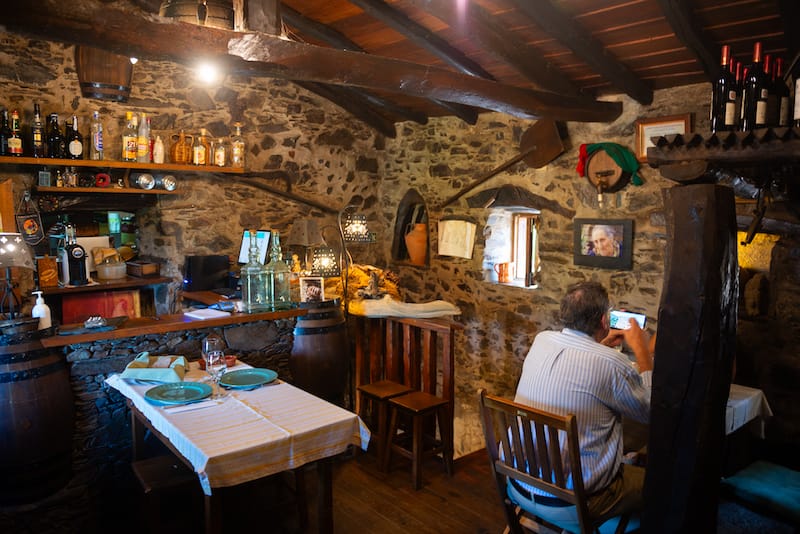
To see the full scope of Aldeias do Xisto, we take several side trips. In the Serra do Açor, in the eastern part of the region, we visit Aldeia das Dez, one of the more cosmopolitan-feeling schist villages. There, Restaurante João Brandão, located in Hotel Rural Quinta da Geia, provides a welcome respite from massive servings of goat via a relatively dainty dish of salt cod baked with a cornmeal crust. The town has a reputation for desserts, and at a tiny shop/cafe in the village center, we buy cavacas, almost merengue-like sweets that combine cornmeal, eggs and a frosting-like coating.

It’s also in Aldeia das Dez that we take advantage of one of the region’s simplest culinary pleasures. “It’s cold – like it came from the refrigerator!” says a woman who’s filling up bottles at the town’s fountain. “Isn’t it good?” We agree heartily, drinking from the tap and filling our water bottles with the cool mountain mineral water, something we’ll do at every subsequent Aldeia do Xisto that we visit.

South of Serra do Açor is the Zêzere group of villages, named for the river that feeds into the Tagus. The remote village of Figueira is largely abandoned except for Casa Ti’Augusta, a former Aldeias do Xisto shop that expanded to a full-fledged restaurant serving local dishes with some subtle twists. The family who run Casa Ti’Augusta and the remaining villagers still use Figueira’s community oven – one of the few in the region that is still in operation. On the day we stop by, it’s still warm from the previous day’s baking.
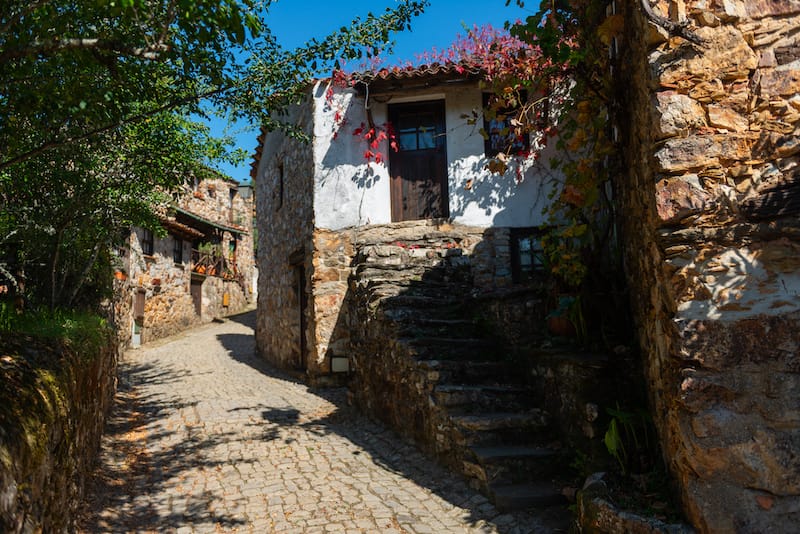
Our last stop in the Aldeias do Xisto is Casal de São Simão, part of the Serra da Lousã group. It’s one of the prettiest villages we’ve been to yet, taking the form of a single lane lined with renovated schist homes, many fronted with flowers. Overlooking these is Varanda do Casal, a restaurant housed in an almost starkly modern-feeling space. Our lunch starts with rye bread baked in a wood-burning oven, and bites that include preserved eggplant, mushrooms braised with bread, and local cream cheese paired with a dollop of pumpkin and walnut jam. Our main dish is empadão – sort of a shepherd’s pie – with oxtail, chestnuts and plums, paired with a crisp, tart green salad and a delicious red from Beira Interior. And dessert spans a pudding made from cheese from nearby Sicó, and an ice cream made from pine nuts. It’s by far the most sophisticated restaurant we encountered in the region. And the dishes, plucking from the local repertoire but light and balanced, formed the best meal we had in the Aldeias do Xisto – a delicious combination of the traditional and the contemporary that just might be the way forward for this rocky, rugged, previously-neglected region.
Tips for visiting Aldeias do Xisto
- Many schist homes are available as vacation stays; they can be booked via the Aldeias do Xisto’s official platform, or via Airbnb or even Google Maps.
- Note that many of the restaurants mentioned in this article and those that are part of the Aldeias do Xisto network are only open on weekends.
- As public transport is limited in the region, and the distances between villages are relatively great, renting a car is the best way to explore the area.
Austin BushAustin Bush
Published on November 23, 2023
Related stories
February 7, 2024
PortoAt first glance, there’s not much to see in Mealhada, a town in Portugal’s central inland Bairrada region about an hour’s drive south of Porto. If there is a main feature here, it’s probably the EN1, the country’s original north-south highway, which slices the town in half, providing a conduit for a seemingly never-ending parade…
January 19, 2024
LisbonIt’s an early example of guilt tripping. The story goes that a monk arrived in a Portuguese village, hungry and clever. He grabbed a rock and carried it door to door, claiming that it was his only ingredient, asking people if they would be kind enough to supplement it so he could make a meal.…
December 7, 2023
PortoMatosinhos, it could be said, has seen better times. In its heyday, the semi-industrial-feeling port city just north of Porto was once home to 54 fish canneries. Today, only two remain. Along the city’s wide, empty-feeling streets, some of the city’s former factories and their graceful Art Nouveau facades have been reappropriated as other businesses…







































